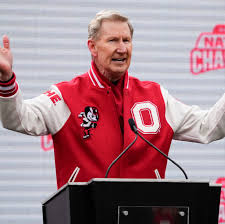Ted Carter, the president of Ohio State, will visit the White House with the Buckeyes next month.
Ohio State University’s football program has a rich history of success, and its recent victory in securing the national championship further solidified its position as one of the elite programs in college football. The 2024 season was particularly memorable, marked by the team’s dominant performances throughout the regular season and their successful run through the newly expanded 12-team College Football Playoff (CFP).
The Buckeyes, under the leadership of head coach Ryan Day, navigated an extremely challenging schedule, with key victories over formidable opponents such as Tennessee, Oregon, and Texas. Their national championship win was capped off by a decisive 34-23 victory over Notre Dame in the championship game. This victory marked Ohio State’s first national title since 2014 and was an exciting moment for fans, students, and alumni across the country.
For the Ohio State football team, the White House visit serves as a symbolic acknowledgment of the hard work, dedication, and athleticism that brought them to the pinnacle of college football. It’s a tradition that signifies not only sports achievement but also the embodiment of values like teamwork, perseverance, and excellence that the program has long stood for.
The White House Visit: A Time-Honored Tradition
For any college sports team, visiting the White House after a national championship is a momentous occasion, often representing the culmination of years of hard work and sacrifice. The tradition, which dates back to the presidency of George H.W. Bush, has been embraced by championship teams across various sports. In this case, Ohio State’s football team will visit President Donald Trump at the White House to commemorate their success.
Coach Ryan Day, who has been with the Buckeyes since 2017 and took over as head coach in 2019, expressed immense pride in leading the team to this achievement. Reflecting on the history of the tradition, Day mentioned how he had long admired teams visiting the White House during his own youth and how it was a dream come true to be in that position himself.
While the trip to Washington, D.C. will be filled with celebrations, it also serves as an opportunity for the team to meet with the President, participate in the ceremonial exchange, and hear from a leader who has previously recognized the accomplishments of other championship-winning teams. This visit follows in the footsteps of the Florida Panthers, who celebrated their Stanley Cup win at the White House in February 2025.
Ted Carter’s Leadership: A Period of Change and Challenge
Ted Carter Jr. took office as the 17th President of Ohio State University in 2023, assuming a leadership role during a time of significant challenges within higher education. Carter, a seasoned academic leader, has faced several hurdles in navigating the complex world of university governance, faculty, student protests, and changing state and federal policies.
One of the most notable and controversial decisions during Carter’s tenure has been his move to shut down several diversity-focused initiatives on campus, including the university’s Office of Diversity and Inclusion and the Center for Belonging and Social Change. This decision sparked protests from students and faculty who felt that these programs were vital to fostering an inclusive and supportive environment on campus, especially given the diverse student body that OSU attracts.
Despite the backlash, Carter has remained firm in his vision for the university. He has publicly stated that his decisions are guided by the broader goal of improving educational outcomes for all students, while also navigating the evolving landscape of higher education policies. His leadership has been marked by a willingness to take bold stances, even in the face of public criticism.
In a recent interview, Carter addressed his views on the broader challenges facing American higher education, including the increasing influence of state and federal governments on university operations. He also commented on the potential changes to federal student aid programs, which could have far-reaching implications for students at Ohio State and other public universities.
Though Carter’s decisions have drawn criticism, his focus on the economic impact of Ohio State on the state of Ohio has been a key theme in his presidency. Under his leadership, OSU has continued to thrive as a major economic engine, contributing billions of dollars annually to the state’s economy.
The Role of the White House Visit in OSU’s Narrative
The White House visit is a moment of celebration that provides an opportunity for Ohio State to shift the focus from the controversies surrounding President Carter’s leadership to the remarkable achievements of the Buckeyes on the field. The visit will allow the Ohio State community to come together and celebrate not just the athletic success of the football team, but also the broader accomplishments of the university as a whole.
For students, alumni, and faculty, the visit represents a moment of pride and unity. It highlights the importance of tradition, especially in the context of Ohio State’s storied history in collegiate athletics. In addition to the national championship win, Ohio State’s football program is also a key driver of school spirit and identity, both on campus and in the broader Columbus community.
The visit to Washington will give the university an opportunity to bask in the positive spotlight of its success, at least for a moment, before returning to the pressing issues that have dominated the university’s administrative agenda. These include the controversial policies surrounding diversity, equity, and inclusion, as well as the ongoing debates about the future of higher education in Ohio and across the nation.
Looking to the Future: Challenges and Opportunities
As Ted Carter continues to steer Ohio State through a period of transition, the university faces both challenges and opportunities. The shift in leadership priorities, particularly concerning diversity and inclusion, has sparked strong debates about the role of higher education institutions in fostering an inclusive environment while balancing other institutional goals.
At the same time, OSU’s growing influence, both regionally and nationally, gives Carter a unique platform to advocate for policies that support the university’s long-term growth and success. Whether through academic advancements, increased funding for research, or greater emphasis on student success, OSU remains a central player in shaping the future of higher education in Ohio.
The White House visit is a reminder of the university’s national prominence, not just in athletics but in its role as a major public institution. In the years to come, it will be important for Ohio State and President Carter to navigate the complexities of university leadership while continuing to achieve excellence in a wide array of fields.



